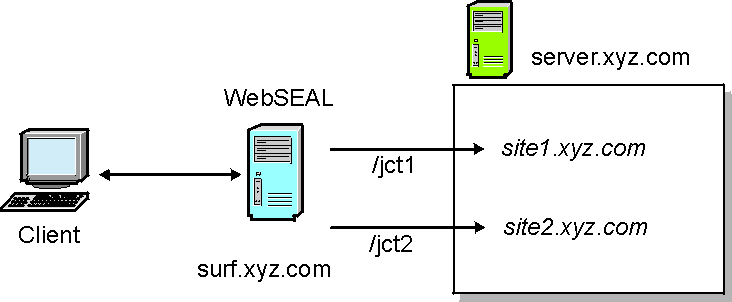Virtual hosting refers to the practice of maintaining more than one WebSEAL instance on the same physical machine. Virtual hosting is used to run multiple Web services, each with different host names and URLs, and which appear to be on completely separate sites. Virtual hosting is used by ISPs, hosting sites, and content providers who need to manage multiple sites but do not want to buy a new machine for each one. Multiple companies can share a single Web server but have their own unique domains, such as www.company1.com and www.company2.com.
Users of virtual host domains do not need to know any extra path information. In requests to a virtual host domain, browsers simply provide the required hostname through its Host: header.
In a standard junction create command, the -h host option and argument identifies the remote junctioned server machine. WebSEAL normally places this server address in the Host: header of requests to this server.
The additional -v host option and argument identifies a virtual host instance on this machine. The virtual host information provided by -v is used in the Host: header instead of the -h information. Requests are now directed to the specific virtual host instance. The -h information is still used by WebSEAL to locate the physical host machine.
For mutual junctions the -v host option corresponds to the virtual host name when the HTTP protocol is used to communicate with the junctioned server.The -V host option is used as the virtual host name when the HTTPS protocol is used.
The following example illustrates the configuration of two virtual hosts. The junctioned application server is server.xyz.com. It runs on port 80 and hosts two virtual servers: site1.xyz.com and site2.xyz.com.
Basic junctions are created as follows (each command entered as one line):
pdadmin> server task default-webseald-surf.xyz.com create -t tcp
-h server.xyz.com -v site1.xyz.com /jct1
pdadmin> server task default-webseald-surf.xyz.com create -t tcp
-h server.xyz.com -v site2.xyz.com /jct2
See also Complete Host header information with -v.